By Fred Manzo
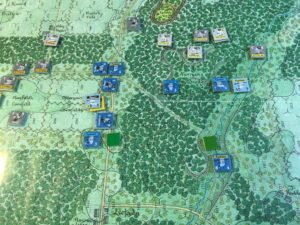
The “Leetown” map, during our last playtest of the campaign game. The counters are done, but this is a prior version of the map.
Hermann Luttmann’s latest game, “Thunder in the Ozarks: the Battle of Pea Ridge” is being released by Revolution Games next month. I was its developer and its artist was Rick Barber. It will contain 2 maps in order to cover the battles of Leetown and Elkhorn Tavern, and it will have a campaign scenario in order to combine them.
It will be employing a continuation of the “Blind Swords” system Hermann used in Duel of Eagles, Hammerin’ Sickles, At Any Cost and Stonewall’s Sword.
During our last playtest of the Thunder in the Ozarks campaign game (or as its known to its D and D team, “Tito”) an interesting development has occurred regarding its Line-of-Sight rules.
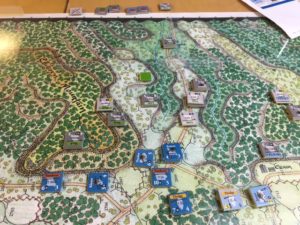
This is the “Elkhorn Tavern” map during the same playtest. The rules are done and the game should be released sometime at the end of next month.
You see, even though most people would rather shy away from LOS rules, if you are going to represent the battle of Pea Ridge at the regimental level some type of LOS rules are required due to its scale and the fact that the battle took place in the middle of 19th century Arkansas. But I never really sat down and analysed their intricacies. I simply memorized their 12 different major cases (or attempted to, anyway).
However, I also always found that when something looks complex it helps to chart it out and search for patterns. So that is what I did this week.
Here are the results:
Now, I’m sure your eyes are starting to glaze over. But working out its steps in a logical manner does reveal an interesting pattern.
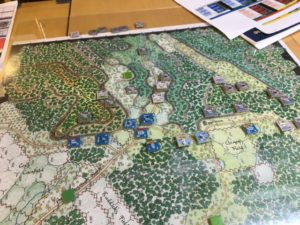
This is the “Elkhorn Tavern” map, once again during our last playtest, but this time it includes the far right Union flank, which has been turned by the Confederates.
Because by simply looking down its extreme right hand “conclusions” column you will notice that there are 12 entries, with 6 of them simply saying “the Line-of-Sight is Blocked,” and the other 6 saying “the LOS is Obscured.” Of course, we could attempt to memorize the 6 “Obscured” situations, but we would then have to take into account the next to last right-hand column and that would involve remembering more data, not less. So let’s stick with the “Blocked” situations and see where they lead.
First, you’ll notice that of the 6 “Blocked” conclusions three are obvious: you can’t see through mountains. So conclusions #1, #3 and #5 should be no problem remembering. That leaves us with only conclusions #2, #4 and #6 to review.
Well, conclusion #2 and #6 are basically the same, in that you can’t see beyond a cliff, unless you or your target are standing at its edge.
That leaves only conclusion #4 to consider: “If the Firing unit and its target are on the same level you can’t see through Heavy Woods or Units.”
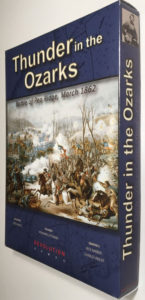 So basically, all 12 Line-of-Sight situations and all their sub-topics boil down to a few simple rules:
So basically, all 12 Line-of-Sight situations and all their sub-topics boil down to a few simple rules:
3. If the firing unit is lower than the target unit any intervening hex at the same level as the target blocks the Line-of-Sight. (of course, items 2 and 3 are simply mirror images of each other).
4. If the firing and the target unit are on the same level, a Heavy Woods or Unit along the Line-of-Sight blocks it (however, if this Line-of-Sight includes only Light Woods the LOS is obscured).
Game Resources:
 Thunder in the Ozarks Home Page
Thunder in the Ozarks Home Page
Thunder in the Ozarks Consimworld page


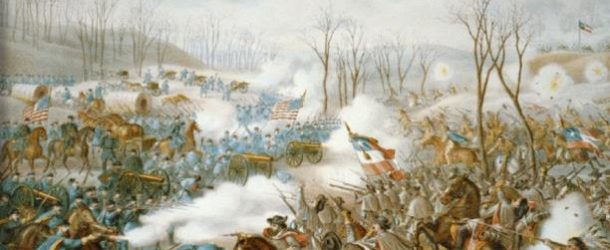
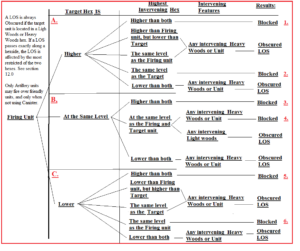






Fred, simplifying LOS rules is always a good thing. I have pasted your four conclusions into the chart you posted. One question: “Ladder” you mean “higher ground than target” or does it need further elaboration? Thanks.
LOS
I was being “smart”. It just means someone has to be higher to see over a lot of trees.
I liked the chart, myself, but not everyone likes complex charts. Building it was worth it, however. That and Herm’s comment that the LOS rules aren’t that complex once you realize you can’t see through cliffs, set off a spark in my brain. Basically, you can’t see through mountains or over cliffs, if someone isn’t standing on their edge or through a lot of trees, unless someone is higher than the trees themselves. And that’s it. Every other feature simply Obscures the LOS.
I just removed the “ladder” reference.
Thanks,
– Fred